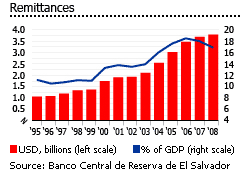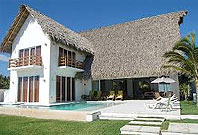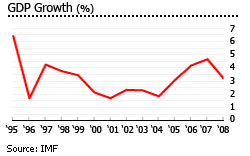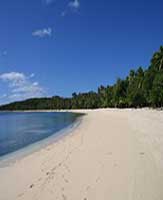El Salvador's real estate<br> market paralyzed by US crisis

El Salvador experienced a property boom from early-2000s to mid-2008, benefitting from billions of dollars of remittances from US-based Salvadorians. But because of the US recession and credit crunch, El Salvador’s real estate market is now frozen.
Thirty per cent of construction firms’ activities have been paralyzed, due to limited bank loans for housing and other infrastructure projects, according to CASALCO (Camara Salvadoreña de la Industria de la Construccion or Salvadorian Construction Industry Chamber).
Remittances from US-based Salvadorians sparked the boom. Now remittances have fallen 8.4% y-o-y to US$252 million in January 2009.
The number of loans rated as unrecoverable, or portfolio class-E, has risen 36.9% y-o-y to January 2009, according to a report by the Central Reserve Bank (BCR) of El Salvador.
El Salvador’s small economy is extremely dependent on the US. The US dollar is the official currency. According to a UNDP study, without remittances, the proportion of households living in extreme poverty would jump from 6%, to 37%. More than 50% of all exports from El Salvador go to the US.
Many overseas Salvadorians buy property in their home town, but few foreigners have been attracted to buy here. El Salvador is notorious for its extremely violent street gangs, known as ‘maras’. Violence between the two biggest maras was so severe that the government had to create two separate prisons for them.
Foreigners prefer to live in San Salvador, the capital, and its surrounding suburbs, protected by gated villages. Other than violence and crime, foreigners are discouraged by frequent natural disasters such as hurricanes, earthquakes, and volcanic activity. The country is also haunted by memories of the bloody civil war from the 1980s to 1992 which left more than 75,000 people dead.
Remittance-induced housing boom ends
There are between 1 and 2 million El Salvador-born US immigrants, including illegal immigrants. Remittances reached US$3.8 billion in 2008, around 17% of GDP.

The government estimates that only 1 percent of these remittances are spent on housing. The money mostly goes to immediate consumption - food, clothing, and household maintenance costs like fuel, electricity and water. To entice US-based Salvadorians to buy housing back in the home country, the government sets up housing fairs in the US, and offers low-interest mortgages.
Even illegal immigrants can benefit from low-cost mortgages of up to US$50,000, as long as they can prove that they have sent money home for six months or more.
These efforts caused a construction boom in coastal areas and major cities. Of the 12 residential property projects listed on the CASALCO website, four were in the department (province) of La Libertad, which faces the Pacific Ocean, and is the nearest coastal area to San Salvador.
The projects were in the province of San Salvador and three in San Miguel, locations of El Salvador’s two biggest cities. One project was in La Paz and one in Sonsonate, departments on the Pacific Ocean.

Property prices for these new developments ranged from US$16,500 for vacant lots in Sonsonate, to more than US$250,000 for luxurious villas in San Miguel. In Altura de Tenerife (Tenerife Heights) in La Libertad, prices can exceed US$500,000 for a 2,220 sq. m. vacant lot with a good view.
While El Salvador’s property prices are lower than in Costa Rica or Panama, they are way beyond the means of ordinary people. The GDP per capita of the average Salvadorian was around US$3,000 in 2008.
Weak economic growth, many problems
El Salvador’s economic growth has historically been sluggish. Massive reconstruction efforts after the end of the civil war pushed GDP up by an average of 6.6% from 1993 to 1995. After that, El Salvador’s GDP growth never exceeded 5%. Average annual GDP growth from 1996 to 2004 was 2.6%. The benefits of the adoption of US dollar in 2001 were felt only while low interest rates lasted, from 2005 to 2007, when El Salvador’s economy grew by 3.97% per annum.
In 2008, GDP growth slowed to 3.2%, due to the financial meltdown and economic recession in the US. The economy is expected to shrink 1.5% in 2009, before recovering in 2010, with a 1% GDP increase.
Calamities routinely hit the country. Hurricane Mitch caused devastation in 1998, leaving 300,000 people homeless. Then two earthquakes in 2001 damaged a further 20% to 25% of the housing stock, with 174,000 houses wrecked, and about 1.5 million people left homeless.

Lack of clear titles is another problem hindering the reconstruction process and the real estate market in general. The problem is exacerbated by inequality, criminality, and by an inefficient and corrupt bureaucracy.
El Salvador is the smallest country in Central America with a land area of 20,720 sq. km. With a population of 7.25 million people in 2008, it is also the most densely populated country in the region.
The left takes over politics
After the end of the civil war in 1992, the right-wing Arena (Alianza Republicana Nacionalista) Party dominated the political scene.
That period came to an end with Arena’s defeat in the 2008 presidential election. Mauricio Funes of the left-wing FMLN (Frente Martipara la Liberacion) Party narrowly won, with 51.2% of votes over Arena’s candidate. He will take office in June 2009.
The FMLN is made-up mainly of former Marxist rebels who fought the government during the civil war, though Funes is an exception: he is the first FMLN presidential candidate who hasn’t served as an armed combatant.

Many businessmen are worried that Funes will follow the wave of socialism spreading across Latin America. However, Funes identifies himself with Brazil’s social-reformist president Lula da Silva, and not with Venezuela’s Hugo Chavez, whose administration is increasingly becoming more authoritarian.
Funes and FMLN have promised to maintain the use of US dollar. They also promise to protect private property, honour El Salvador’s foreign debts and obligations, and implement trade agreements signed by their predecessors.
Funes will likely encounter rough sailing in congress, with no clear majority. This may protect the country from radical economic changes, but it could delay desperately-needed reform.